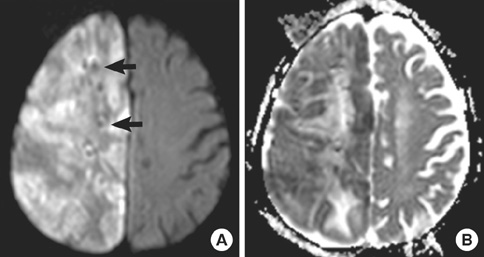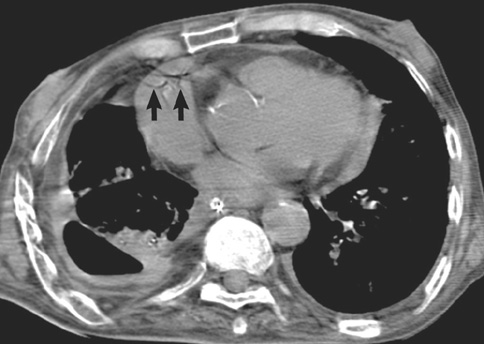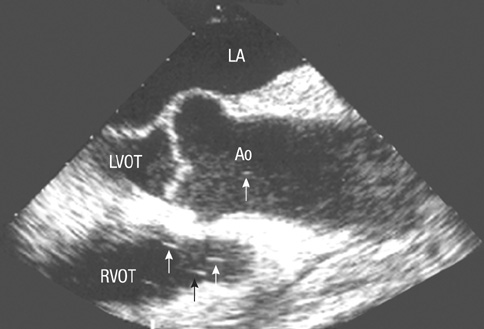Massive Paradoxical Air Embolism in Brain Occurring after Central Venous Catheterization: A Case Report
- Affiliations
-
- 1Department of Internal Medicine, Kangwon National University, School of Medicine, Chuncheon, Korea.
- 2Neuroscience Research Institute, Kangwon National University, School of Medicine, Chuncheon, Korea. samskim@kangwon.ac.kr
- KMID: 2157864
- DOI: http://doi.org/10.3346/jkms.2010.25.10.1536
Abstract
- Cerebral air embolism is a rare but fatal complication of central venous catheterization. Here, we report a case of paradoxical cerebral air embolism associated with central venous catheterization. An 85-yr-old man underwent right internal jugular vein catheterization, and became obtunded. Brain MR imaging and CT revealed acute infarction with multiple air bubbles on the side of catheter insertion. The possibility of cerebral air embolism should be considered in patients developing neurological impairment after central venous catheterization, and efforts should be made to limit cerebral damage.
MeSH Terms
-
Aged, 80 and over
Brain/pathology
Catheterization, Central Venous/*adverse effects
Echocardiography, Transesophageal
Embolism, Air/*etiology/ultrasonography
Embolism, Paradoxical/*etiology/ultrasonography
Humans
Intracranial Embolism/*etiology/ultrasonography
Magnetic Resonance Imaging
Male
Tomography, X-Ray Computed
Figure
Cited by 3 articles
-
Cerebral Air Embolism: a Case Report with an Emphasis of its Pathophysiology and MRI Findings
Se Ri Kang, See Sung Choi, Se Jeong Jeon
Investig Magn Reson Imaging. 2019;23(1):70-74. doi: 10.13104/imri.2019.23.1.70.Cerebral Air Embolism Following Thyroid Biopsy
Yun Su Hwang, In Hwan Lim, Hyun Goo Kang, Jin Sung Cheong
J Neurocrit Care. 2016;9(1):45-49. doi: 10.18700/jnc.2016.9.1.45.Cerebral air embolism and subsequent transient neurologic abnormalities in a liver transplant recipient following the removal of the pulmonary artery catheter from the central venous access device: a case report
Sun-Key Kim, In-Gu Jun, Dong-Min Jang, Jinwook Lim, Gyu-Sam Hwang, Young-Kug Kim
Korean J Anesthesiol. 2016;69(1):80-83. doi: 10.4097/kjae.2016.69.1.80.
Reference
-
1. Scott WL. Complications associated with central venous catheters. A survey. Chest. 1988. 94:1221–1224.2. Muth CM, Shank ES. Gas embolism. N Engl J Med. 2000. 342:476–482.
Article3. Layon AJ. Hyperbaric oxygen treatment for cerebral air embolism - where are the data? Mayo Clin Proc. 1991. 66:641–646.4. Turnage WS, Harper JV. Venous air embolism occurring after removal of a central venous catheter. Anesth Analg. 1991. 72:559–560.
Article5. Black M, Calvin J, Chan KL, Walley VM. Paradoxic air embolism in the absence of an intracardiac defect. Chest. 1991. 99:754–755.
Article6. Mennin P, Coyle CF, Taylor JD. Venous air embolism associated with removal of central venous catheter. BMJ. 1992. 305:171–172.
Article7. Boer WH, Hene RJ. Lethal air embolism following removal of a double lumen jugular vein catheter. Nephrol Dial Transplant. 1999. 14:1850–1852.
Article8. Vesely TM. Air embolism during insertion of central catheters. J Vasc Interv Radiol. 2001. 12:1291–1295.9. Teichgräber UK, Benter T. Air embolism after the insertion of a central venous catheter. N Engl J Med. 2004. 350.
Article10. Peters JL, Armstrong R. Air embolism occurring as a complication of central venous catheterization. Ann Surg. 1978. 187:375–378.
Article11. Ploner F, Saltuari L, Marosi MJ, Dolif R, Salsa A. Cerebral air embolism with use of central venous catheter in mobile patient. Lancet. 1991. 338:1331.12. Heckman JG, Lang CJ, Kindler K, Huk W, Erbguth FJ, Neundorfer B. Neurologic manifestations of cerebral embolism as a complication of central venous catheterization. Crit Care Med. 2000. 28:1621–1625.13. Hinkle DA, Raizen DM, McGarvey ML, Liu GT. Cerebral air embolism complicating cardiac ablation procedures. Neurology. 2001. 56:792–794.
Article14. Miller WC, Heard JG, Unger KM. Enlarged pulmonary arteriovenous vessels in COPD. Another possible mechanism of hypoxemia. Chest. 1984. 86:704–706.15. Yeh YL, Liu CK, Chang WK, Chan KH, Li JY, Tsai SK. Detection of right to left shunt by transesophageal echocardiography in a patient with postoperative hypoxemia. J Formos Med Assoc. 2006. 105:418–421.
Article
- Full Text Links
- Actions
-
Cited
- CITED
-
- Close
- Share
- Similar articles
-
- Cerebral Air Embolism after Central Venous Catheter Removal in a Patient with a Patent Foramen Ovale: A Case Report and Literature Review
- Hemomediastinum Caused by Central Venous Catheter
- J-guide Wire Knotting during the Central Venous Catheterization: A case report
- Stroke Caused by Cerebral Air Embolism after Central Venous Catheter Removal: A Case Report
- Cerebral Air Embolism Following Central Venous Catheterization in a Patient with Idiopathic Pulmonary Fibrosis





